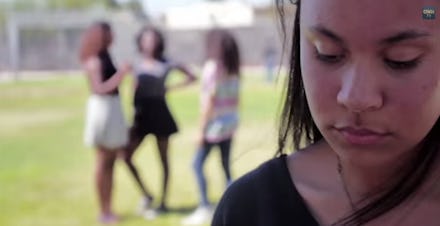Here's What The Conversation About Race Looks Like When You Remove White People

Racism and prejudice are often discussed in the context of white versus black. But removing white people from the conversation is only the first step toward unpacking the deep roots of racism. As the new documentary Light Girls makes clear, whiteness still informs ideals of beauty and worth within the black community in America, as well as other communities of color around the world.
Light Girls, which premiered on OWN last night, is Bill Duke's sequel to his 2011 documentary Dark Girls, both documentaries examine how colorism — the privileging of lighter skin — works within and between communities of color, and how skin-color is tied to cultural values and stereotypes. Comprising over 250 interviews with light-skinned black men and women, the documentary features high-profile celebrities like Soledad O'Brien, Raven-Symoné, Michaela Angela Davis, Tatyana Ali, Amber Rose and more.
Source: OWN
From racism to colorism: Prejudice operates on many levels. In an interview with the Los Angeles Times, filmmaker Duke explained the difference between racism and colorism as prejudice operating between communities versus working within communities. "Exterior people of other cultures and other races commenting on the lack of worth based upon a woman in [black] culture's skin tone is called racism," he said. "With us critiquing ourselves, that's colorism; that's self torture. But when people see us doing what we do to each other, it gives them permission to do it to us to a certain extent."
The documentary makes evident that prejudice is based on societal values, which historically have themselves been dictated by the lightness of one's skin. The consequence is the fracturing of communities, dividing people by #TeamDarkGirls and #TeamLightGirls. Dark-skinned women, Duke conveys, face stereotypes that they are "ugly, stupid or unattractive based upon the darkness of their skin." Light-skinned women, on the other hand, are assumed to be privileged because of their lightness — but at the same time "not black enough," unworthy of their black identity. As one interviewee said, "Being mixed is both a curse and a blessing. It's a curse because you don't really belong anywhere, but it's a blessing [because] you get to blend in everywhere. [...] I don't know anything about the black experience, and I have no right because my skin color doesn't match."
Duke's sentiments concur with this statement, "Pain has no color, but there's a separation socially. It's assumed that light-skinned women have no problems or issues, but they are judged before you know who they are. The thing is one group thinks it's going through more pain than the other."
Source: OWN
Erasing white people doesn't erase the power of whiteness: Duke's documentaries demonstrate that men and women of color are constantly measured against the ideals of whiteness, even within their own communities.
For women of color, for example, colorism has had disastrous effects for sisterhood and feminism in general. "Black women have been cultured to compare and not connect," filmmaker and activist Michaela Angela Davis said. Without connecting — without understanding both our differences and how these differences are evaluated by societal standards — there is no hope for a movement.
At a time when activism like the Black Lives Matter movement has reached its apex, Light Girls expands the discussion about race to include prejudice within communities of color. "Colorism," Nneka M. Okona writes for ForHarriet, has been "pervasive and damaging" because of "its deeply embedded roots in the psychological fabric of Black folks here in the United States." As a deeper, more insidious foundation of racial prejudice and oppression, colorism "is the ghost of European colonialism, Eurocentrism, and global White supremacy. It is the notion that our skin and our humanity is only measurable, valuable, and worthy in its proximity to Whiteness."
Light Girls offers hope that with these conversations about how racial prejudice functions at multiple levels throughout society, we can build new channels of understanding and acceptance.